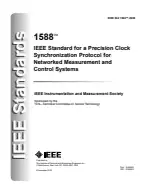IEEE Standard for a Precision Clock Synchronization Protocol for Networked Measurement and Control Systems
Also Known As: IEEE Std 1588-2002
Abtract:
Replaced by IEC 61588-2004 (SH95292 or SS95292) Dual-logo document Abstract: A protocol to synchronize independent clocks running on separate nodes of a distributed measurement and control system to a high degree of accuracy and precision is specified. The protocol is independent of the networking technology, and the system topology is self-configuring.
Scope:
This project will define a protocol enabling precise synchronization of clocks in measurement and control systems implemented with technologies such as network communication, local computing and distributed objects. The protocol will be applicable to systems communicating by local area networks supporting multicast messaging including but not limited to Ethernet(tm). The protocol will enable heterogeneous systems that include clocks of various inherent precision, resolution and stability to synchronize. The protocol will support system-wide synchronization accuracy in the sub-microsecond range with minimal network and local clock computing resources. The default behavior of the protocol will allow simple systems to be installed and operated without requiring the administrative attention of users.
Purpose:
Measurement and control applications are increasingly using distributed system technologies such as network communication, local computing, and distributed objects. Many of these applications will be enhanced by having an accurate system-wide sense of time achieved by having local clocks in each sensor, actuator, or other system device. Without a standardized protocol for synchronizing these clocks, it is unlikely that the benefits will be realized in the multi-vendor system component market. Existing protocols for clock synchronization are not optimum for these applications. For example NTP, Network Time Protocol, targets large distributed computing systems with millisecond synchronization requirements. The protocol proposed in this PAR specifically addresses the needs of measurement and control systems: · Spatially localized, · Microsecond to sub-microsecond accuracy, · Administration free, and most importantly, · Accessible for both high-end devices and low-cost, low-end devices.
| Descriptors | Patents, Licenses, Clocks, Synchronization, Control systems |
| ICS Codes | 39.040.99 - Other time-measuring instruments |
| Language(s) | English |
| ISBN | 978-0-7381-3370-6 |
| File Size | 993.3 KB |


